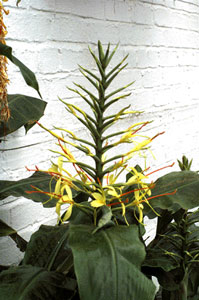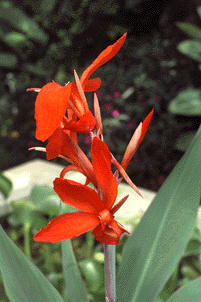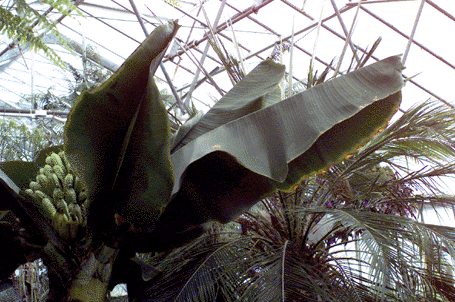Order Zingiberales
 Zingiberaceae: Ginger family
Zingiberaceae: Ginger family
The 1000 species in the ginger family are almost all tropical and mostly occur in moist forests or wet open places. Their broad leaf blades may be an adaptation to a forest habitat, with low light and little wind.
Right: the showy inflorescences of this family are illustrated by Hedychium gardnerianum. From Malaysia, India, China.
The ginger plant itself is Zingiber officinale. It is probably native to SE Asia, but has been widely introduced in the tropics. Members of this family often have tuberous rhizomes, which in the case of Z. officinale are the source of ginger. Preserved green ginger, mainly Chinese in origin, is the peeled rhizome, boiled and stored in syrup. The spice is obtained from peeled, sun-dried rhizomes. Ginger was used from ancient times in India and China, and was first described in Europe in 1292. It was introduced to the New World very early, and Jamaican ginger was being exported to Spain by 1547.
Cannaceae
In the pond is the Canna 'lily' (below) found in tropical and subtropical regions of the New World. The flowers look unusual because they are irregular and obliquely oriented.

Musaceae: Banana family
Below: Musa cavendishii. The best known crop plant in the Zingiberidae is the banana Musa from tropical and subtropical regions of the Old World. This large plant is a herb because, like all monocots, it has no secondary thickening. Bananas are propagated vegetatively by their basal corms. The visible plant consists of 'pseudostems' of overlapping leaf sheaths. The fruit-bearing inflorescences are thrust up the centre of the pseudostem by elongation of the true stem; one is emerging in this picture.
The edible bananas probably originated in the Malay peninsula, with human selection favouring parthocarpic, seedless fruits. The crop reached W Africa before European contact. By the end of the sixteenth century, bananas were widespread throughout the tropics. The banana export trades developed mainly in tropical America in the late nineteenth century.

